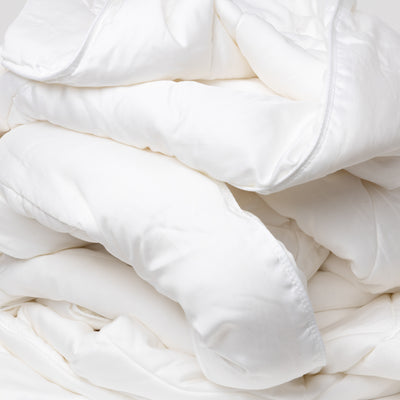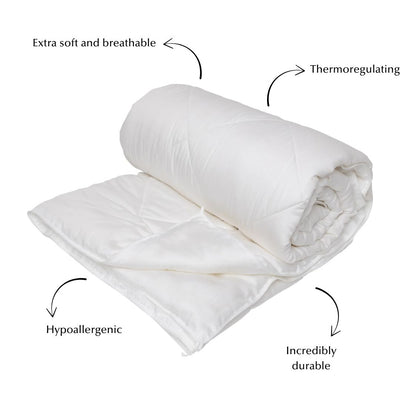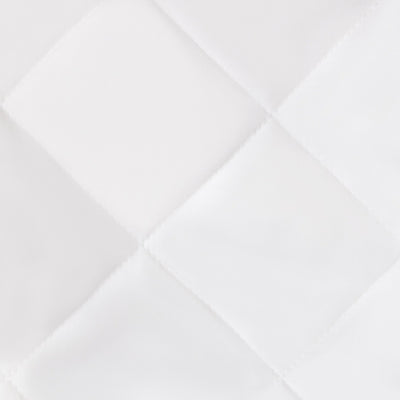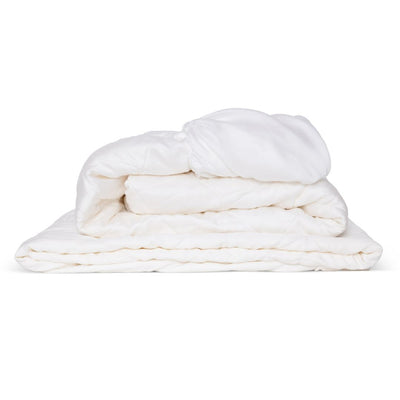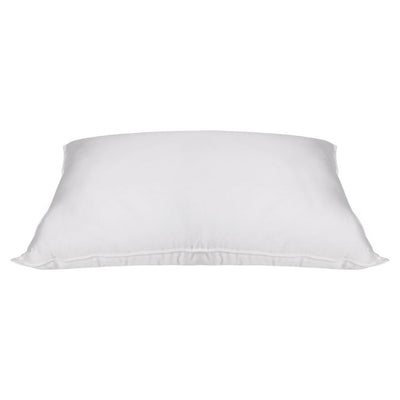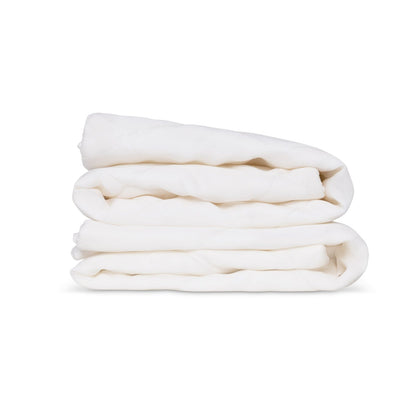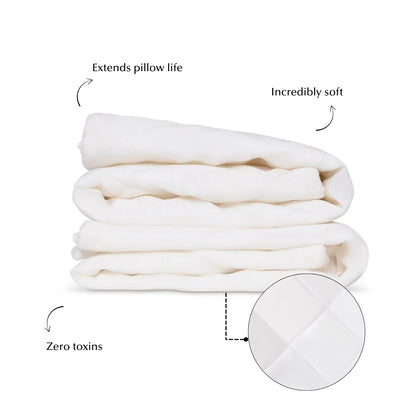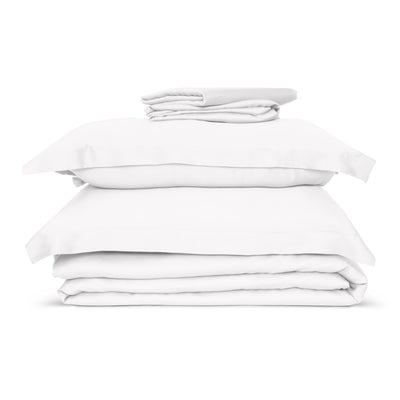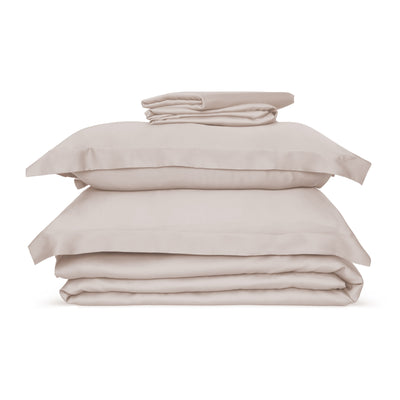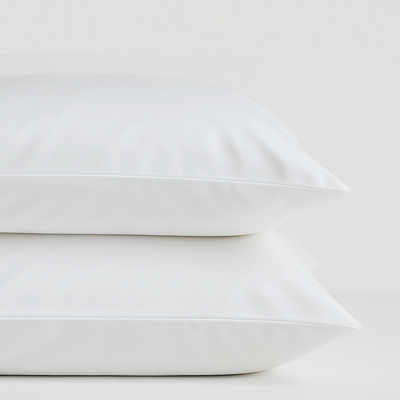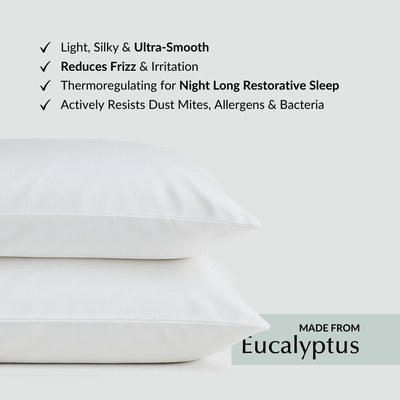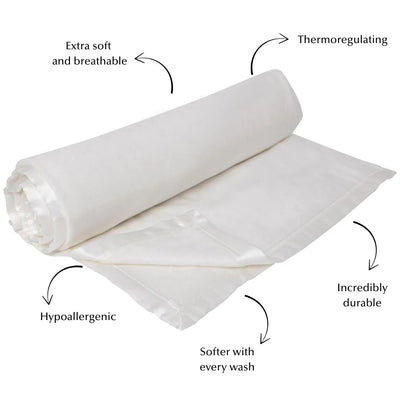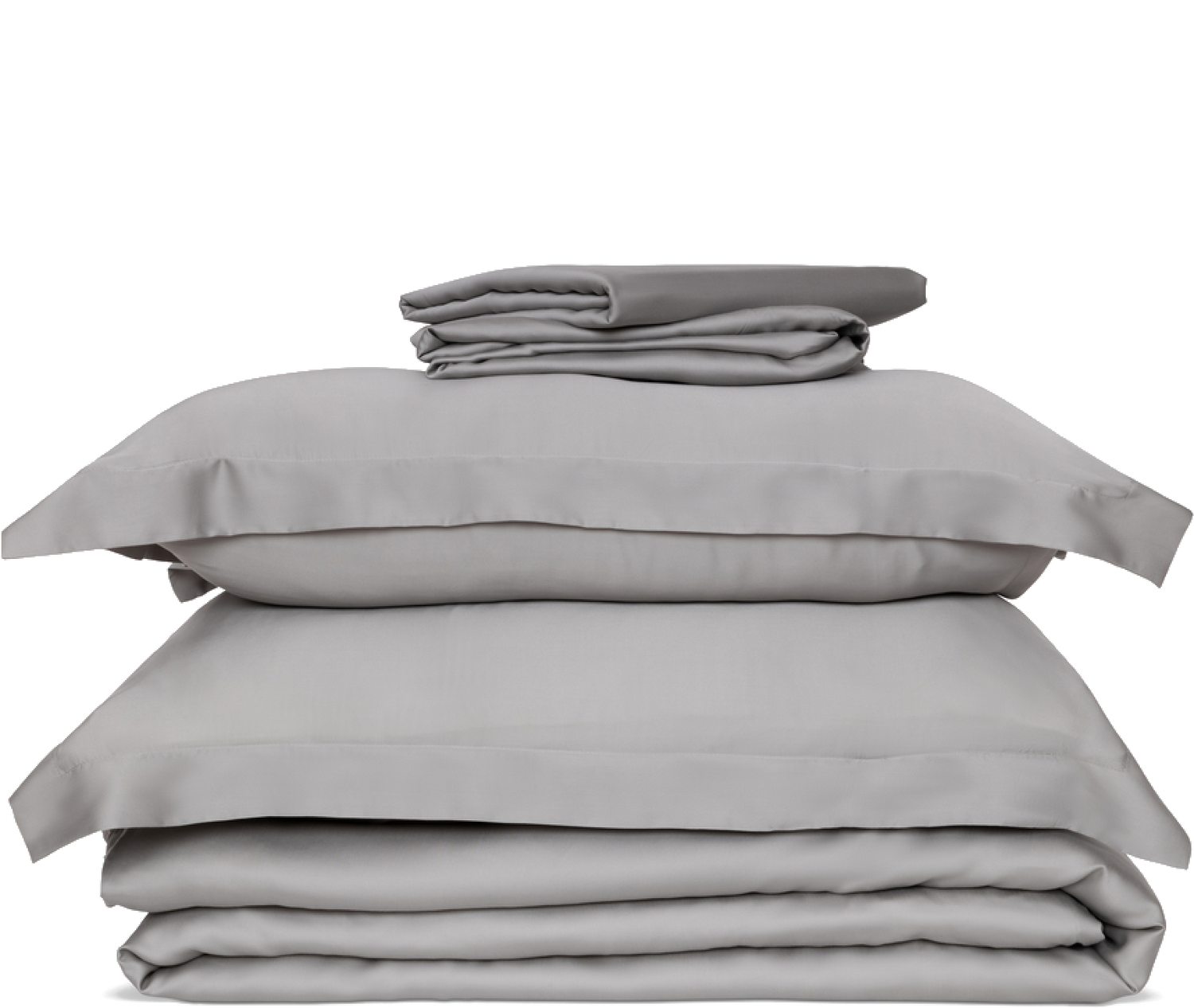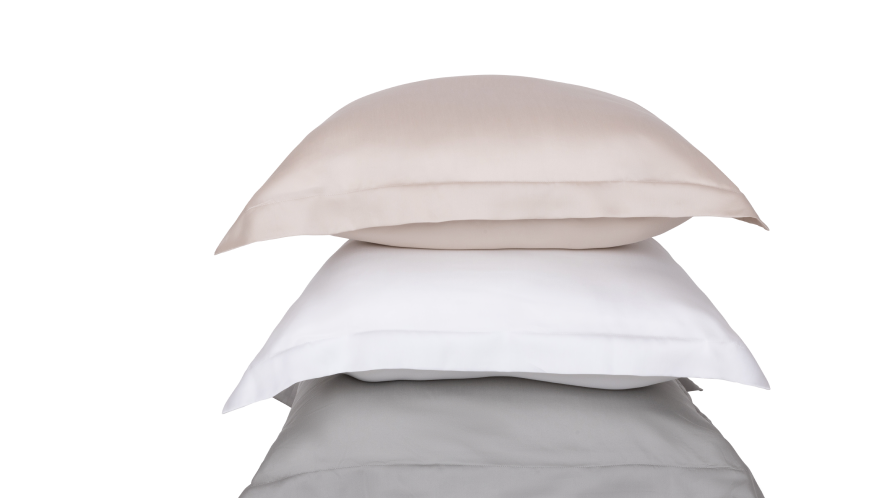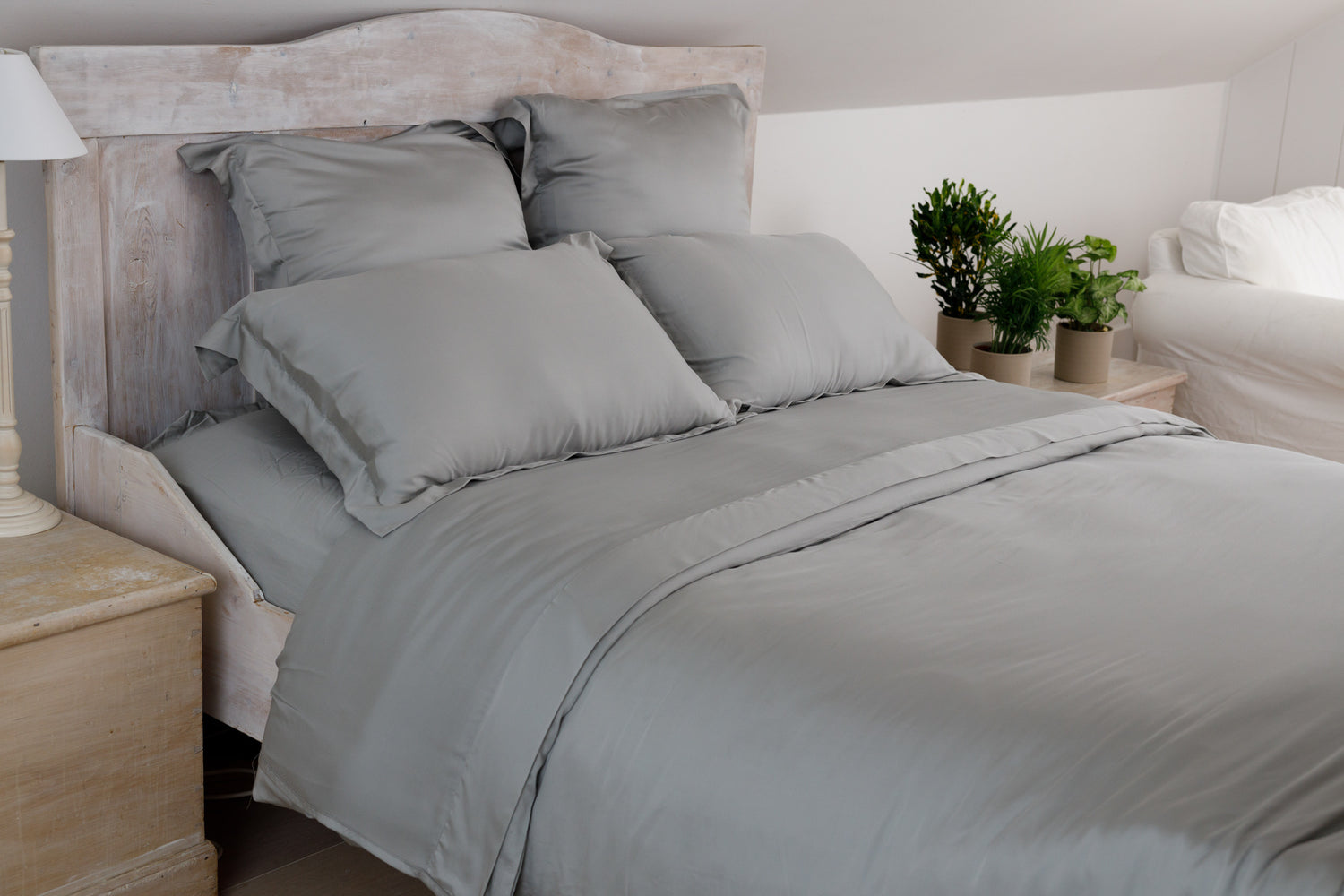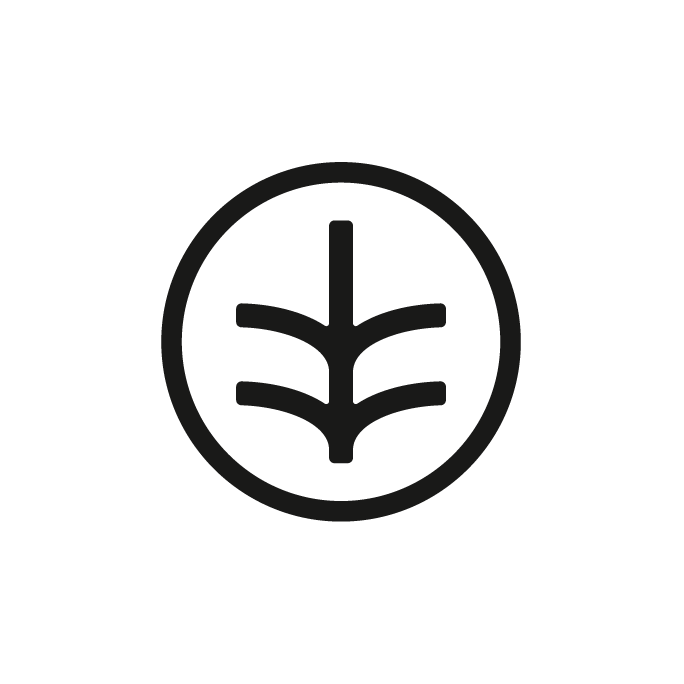Ahhh, sleep. It is one of life’s little pleasures. Not just for sustenance and survival, sleep plays such a major role in our lives that we spend a third of it in bed!
Quality bed sheets are one of the greatest comforts we can have. Bedding should be made of top-quality materials designed to make you drift off to sleep on a white, puffy cloud.
Plenty of low quality bedding is available, but why? Good quality bedding lasts for years more, and allows you a much more luxurious rest at a fraction of a price more once you take into account the increased durability.
This blog post will tell you all about two wonderful fabrics for your bed sheets - percale cotton and eucalyptus Tencel. In this post, we will cover:
- What is percale
- Percale - A Brief History
- Features of Percale
- Benefits of Percale Cotton
- How to care for percale sheets
- Other common types of fabric
- Environmental impact of percale cotton
- Why you should choose percale sheets for your home
- Where to buy percale sheets
- FAQ on percale sheets
- Ethical Bedding - Eucalyptus Tencel Sheets
- Why eucalyptus Tencel is better than percale.
- Sateen weave, what it is, comparisons
- Why Tencel has superior elements for their bedding, duvets, pillowcases
1. What Is Percale?
Percale is a cotton fabric that has been woven in such a way as to create an extremely strong, durable weave. The waft and weft of percale are very smooth and thin.

It is a crisscross weaving that uses a one-yarn-over and one-yarn-under weaving pattern that results in a tightly woven fabric. The tightly woven fabric is a luxuriously soft, lightweight, and breathable matte material with its classic crisp feel, which makes percale popular.
It's a perfect material for sheets because it's breathable and doesn't cause you to overheat while you sleep. Many people who prefer a cooler sleep environment love percale sheets!
Identifying percale sheets does not rely on colour or pattern, but rather on their construction and quality.
Percale is commonly used to produce materials such as beddings, towels, and other bedding materials.
Unlike other weaves, this construction creates a very fine fabric that allows air to flow through more easily than other materials.
Since it can be created with different size yarn threads, percale sheets of varying thicknesses are available.
Types of percale sheets include: plain, needle count (measuring the number of yarn threads per linear inch), thread-count (the total number of yarn threads in either one or both directions) and thread weight (specifically, the weight, in grams, of 450 yards of fabric).
Percale can be made using cotton or a cotton/polyester blend.
2. Percale - A Brief History
Percale comes from the Persian word “pargalah” which means rag. One theory is that percale originated from India, where early types of percale were woven on looms.

The percale was exported around the world in the 17th and 18th centuries. It then caught the attention of textile manufacturers from France, which began the manufacturing and marketing of fabrics that adopted the percale weave.
Another school of thought believes that percale has origins in ancient Persia (modern-day Iran), where the finest fabrics were often woven of silk and wool. When silk became less accessible during the Middle Ages, linen was used for most clothing.
Linen is more absorbent than silk, and tends to dry more quickly when washed.
In 19th-century Europe, a fine linen called batiste was developed in France. The invention of polyester in 1935 led to a new age of inexpensive, easy care fabric.
While cotton fabrics were traditionally starched during manufacturing to make them easier to handle and maintain their pressed appearance, polyester fabrics could be manufactured in a nearly finished state.
It wasn't long before the manufacturers discovered that poly-cotton blends could be produced to mimic the look of cotton percale at a fraction of the cost.
Today, percale is used for sheets on beds around the world.
3. Features Of Percale
Percale has unique features that set it apart from other fabrics.
Material
Percale is mostly made from cotton because of its lightweight and airy feel. Various types of cotton can be used for percale, such as long-staple cotton, organic cotton, and cotton blend.
Long-Staple Cotton
Extra-long-staple (ELS) cotton and long-staple cotton fibres are from Egyptian or Pima cotton. The long fibres are great for percale weaves because it allows having higher thread counts, resulting in a softer, durable, and more breathable fabric.

It is also less likely to fray and wrinkle. The ELS cotton fibres are of the finest quality, which makes them more expensive than the long-staple cotton fibres.
Organic Cotton
Organic cotton is grown from organic plantations that do not use fertilisers and chemical treatments. And yes, organic extra-long-staple cotton fibres and long-staple cotton fibres also exist. Be prepared to shell out more though!
Aside from the benefits of ELS and long-staple cotton fibres, organic cotton fibres are antimicrobial and hypoallergenic, making them an excellent choice for babies or folks with sensitive skin.
Organic percale sheets are also more durable, more comfortable, and more breathable. Since it does not use any chemicals and pesticides, farming organic cotton is good for the environment and lessens pollution.

Some brands sell bedding materials with organic materials. To check the authenticity of your organic sheet, it should have a Global Organic Textile Standard (GOTS) label.
The GOTS is an internationally recognized organic textile standard that guarantees that the product is made according to strict environmental standards and is free of harmful chemicals.
Blended Cotton
Percale can also be made from blended cotton and other fabric such as polyester, silk, bamboo, or rayon. Although they are less breathable, they are wrinkle-resistant. In addition, blended cotton tends to be more affordable.
Thread Count
Thread count is the number of threads woven into a square inch of fabric. The minimum thread count for percale sheets is 180.

However, a high-quality percale sheet has a thread count range from 200 to 400. This thread count is also recommended by the National Sleep Foundation to experience optimal coolness and comfort.
Since percale has high thread counts, it may feel sturdy at first but it will eventually soften after several washes.
Percale sheets can be made either with single-ply or multi-ply threads. The ply refers to the number of yarns twisted to make a thread.
Single-ply threads can produce lightweight, durable, and soft percale sheets while the multi-ply threads can produce percale sheets that are not as soft and as durable as the ones made from single-ply.
Pros
- Smooth and crisp
- Resistant to pilling
- Breathable
- Good for summer and hot sleepers
- Affordable
- Easy to launder
Cons
- Can be wrinkly, except for blended cotton that can be wrinkle-resistant
- Too cool for cold climates or cold sleepers
- Can make noise when the sleeper moves
4. Benefits of Percale Cotton
Smoothness
The percale sheets are smooth and have a luxurious feel in them because of the cotton fibres that are tightly and finely woven.
Breathability
Percale sheets are made from cotton, which is lightweight, airy, and breathable. Even if it is tightly woven, it does not trap the heat. Percale is great to use in warm climates or for hot sleepers.

Durability
The percale sheets are durable and strong because they are tightly woven. It does not pill or does not break easily, even after getting softer with each wash.
Low Maintenance
Since most percale sheets are made from cotton, they can be easily washed at home. Washing and care instructions vary depending on the product. Be sure to read the instructions on the care tag before washing.
Affordable
The price of percale sheets varies from the raw materials used. Top-quality cotton with long fibres generally cost more.
5. How To Care For Percale Sheets
Percale sheets are easy to maintain and take care of. Always check the washing and care instructions of your sheets!
Washing
In washing your percale sheets, separate it from your other clothes and towels to prevent rips or tears from buttons and zippers.
You can machine-wash the percale sheets using mild detergent and in a gentle cycle to avoid the threads breaking. It is best to use cold water in cleaning percale sheets because it can reduce the shrinkage of cotton sheets. Hot water, on the other hand, can fade colours and can be harsh on fine threads.
You can wash your percale sheets at least once a week. Don’t worry because washing will not deteriorate the quality of percale sheets much.
However, the percale sheets may shrink slightly after the first wash, but the size will remain the same after the first wash. Percale sheets even get softer and smoother after every wash!
Drying
You can line dry or tumble dry the percale sheets in a low heat setting. Before placing the washed percale sheets into the dryer, shake them from the washer.
Once you place it into the dryer, set the dryer in a low heat setting. Too hot a temperature may cause the percale sheets to wear out quickly.
Promptly remove percale sheets from the dryer as soon as it dries to have lesser wrinkles on the sheets.
6. Other common types of fabric
Other Common Types of Fabric
If percale is not for you, there are a plethora of fabrics out there that can make good bedding material.
Cotton
Cotton is the most common type of fabric that is used in making sheets and other bedding materials. However, not all cotton is created equal! Some of the different types include:
Egyptian Cotton - The highest quality cotton found in the Nile region in Egypt. This is the most luxurious and expensive cotton. It is usually made from extra-long-staple fibres which makes the softest, smoothest, and most durable fabric.
Pima Cotton - Also high-quality cotton that has medium to extra-long-staple fibres known for its softness, durability, and natural sheen. It grows in the US, Peru, and Australia.
Upland Cotton - Upland has short-staple cotton fibres compared to Egyptian and Pima cotton. This is affordable and durable but not as soft as the other types. Most materials that are claimed to have been made from 100% cotton, if not specified, are made from Upland cotton.
MicroCotton - Micro is a trademarked brand of very fine cotton that is developed in India. It is not only durable and soft, but it is also super absorbent.
Organic Cotton - The best cotton is grown without using pesticides and other chemicals. It is eco-friendly and hypoallergenic, which is perfect for kids and people with sensitive skin and allergies.
Pros:
- Cotton is a soft, durable, breathable, and cool fabric that is perfect for hot sleepers and warm climates.
- It is easy to clean.
- The quality of the fabric gets smoother every after wash
- It has wide variations from budget, style, and size
Cons:
- It is prone to wrinkling.
- Cheaper cotton sheets can degrade over time, which can result in thinning and tearing.
Polyester
Polyester is the most widely used synthetic fabric. It is a man-made fabric that is produced from polymers, which are also used to make plastic bottles.

Since most pure polyester sheets are stiff and rough, it is often blended with other materials, such as cotton, to provide softer and more comfortable sheets.
Pros:
- Easy to wash
- Wrinkle-resistant
- Water-resistant
- Stain-resistant
- Inexpensive
Cons:
- Absorbs oil and grease
- Stiff and rough if made purely from polyester only
- Prone to pilling
- Traps heat, which is not suitable for warm climates
Silk
Silk is the most premium, pricey, luxurious fabric. It is made from natural fibres produced by silkworms.
Silk is soft and cool and has a rich look in it that is a great addition to your bedroom for a romantic, luxe feel. Silk fabric is also hypoallergenic that is suitable for people with allergies and sensitive skin.
Pros
- Very soft and comfortable
- Naturally hypoallergenic
- Repels dust mites, moulds, and mild dews
- Quickly draws moisture from the skin
Cons
- Expensive
- Delicate
- Care and maintenance is difficult
- Stains easily
Microfiber
Microfiber is made from polyester and nylon that is woven tightly. It is perfect for all age groups, especially for children because it is very stain-resistant and softer than polyester.

Pros
- Durable
- Stain-resistant
- Wrinkle-resistant
- Retains colour
Cons
- Not as breathable as cotton
- Retains body heat, so it is only good for cold weather
- Very static and conducts electricity, which causes an undesirable feeling
- Pills after multiple washing
Bamboo
Bamboo sheets have been increasingly popular because they are eco-friendly. It is made from bamboo fibres, making it strong and providing the softness of cotton and smoothness of silk.
Pros:
- Hypoallergenic
- Durable
- Breathable
- Reduces moisture
- Not prone to pilling
Cons:
- More expensive than percale and Upland cotton
- Not all are purely made from bamboo. There are bamboo fibres that are chemically processed, which can minimise some of its benefits and make it less eco-friendly
- Does not retain heat, so it is not suitable for cold weather
Linen
Linen is made from natural fibre produced from flax. It is a light and breathable fabric that provides coolness in warm weather. It is thicker than cotton, which makes it strong and durable. Oftentimes, linen and cotton are blended to produce very breathable fabric.
Pros
- Hypoallergenic
- Moisture-absorbent
- Easy to care
- Extremely strong and durable
Cons
- Stiff, especially at the beginning
- Prone to wrinkling
Tencel
Tencel is a branded material made from Lyocell and Modal fibres. Lyocell is made from wood pulp, particularly eucalyptus trees, which makes it a sustainable and eco-friendly material.
Tencel is very durable and soft, wicks moisture, and wrinkle-resistant. In addition, eucalyptus trees are fast-growing, hardy trees that require little to no pesticides to grow.
Tencel is one of the most environmentally-friendly materials and an excellent choice for bedsheets.
Pros:
- Environment-friendly
- Wrinkle-resistant
- Soft and Durable
- Absorbs moisture
Cons:
- Not as breathable as cotton
- May feel clammy
- Expensive than cotton because of its complicated manufacturing process
Satin
Satin is usually woven from a mixture of silk and other fabrics such as polyester, wool, and nylon. Smooth, cool, and silky, satin has an alluring feel that is luxurious and romantic.

Pros:
- Soft and comfortable
- Easily dyed
- Cool and does not trap heat
Cons:
- Not suitable for cold weather
- Expensive
- Not durable as others
Flannel
Flannel is made of wool or woven cotton that is brushed to fluff up the fibres. The brushing can raise the nap, which softens and makes the material denser.
Flannel is warm and cosy because it traps body heat, making it ideal for cooler climates. The quality of flannel is not measured by thread count but in ounces per square yard. Five ounces can produce a warm and long-lasting sheet.
Pros:
- Suitable for colder climates
- Does not wrinkle easily
- Soft and comfortable
Cons:
- Slightly heavy
- Takes a long time to dry
- Too warm for summer climate
7. Environmental Impact of Percale Cotton
Although booming, the fashion and textile industries have long been demonised for being incredibly detrimental to the environment.
The fashion industry is estimated to produce 2 to 8 percent of global carbon emissions, which greatly contributes to global climate change. (Source)
Meanwhile, the textile industry is the biggest contributor to microplastics entering the ocean, harming sensitive aquatic life and killing marine animals. (Source)
Synthetic Fabric
Synthetic fabrics, such as polyester, nylon, and rayon, are man-made fabrics that are made from chemical and fossil fuel resources.

Since they are made from fossil fuels, the manufacturing process of synthetic fibres emits tons of global emissions of carbon dioxide and causes depletion of fossil fuel resources.
Synthetic fabrics, particularly polyester, are made from polyethylene terephthalate, which is also used for producing plastics. They significantly contribute to plastic pollution because they are non-biodegradable, taking hundreds of years to break down in landfills.
In addition, washing clothes contributes to 35% of microplastic pollution in the ocean.
Microplastics are plastic debris that is less than five millimetres in length, which can easily get through a water filtration system.
It is the most prevalent type of marine debris that is found in oceans and lakes. It can pose problems to the health of sensitive marine animals when ingested, can absorb toxic chemicals, and can expose organisms to toxins.
Cotton
It is not only synthetic fabrics that pose a threat to the environment, but the cotton industry is a brutal one.
Traditionally-grown cotton has a huge impact on the environment, causing soil degradation, pollution, high water consumption, greenhouse gas emissions, and usage of harmful fertilisers and pesticides.
Cotton farmers use 6% of the world’s pesticides and 16% of insecticides in growing cotton, which is more than a single major crop. (Source)
These pesticides and insecticides contribute to global carbon dioxide emissions and even pollute drinkable water, often in developing countries with no means to protect themselves.
This does not only harm the environment but also poses health risks to the farmers. Pesticide poisoning, miscarriage, and chronic illness such as cancer are a few of the health impacts of pesticides and insecticides on humans.
Cotton production is a water-intensive industry. It takes around 2700 litres of water to produce one cotton shirt!
The high volume of water takes it away from the natural sources, resulting in soil salinization.
If cotton is chemically processed or mixed with other synthetic materials, like what the fashion and textile industry usually do, it causes massive amounts of pollution worldwide.
Eco-friendly Movement
With the alarming effects of the fashion and textile industry on the environment, the movement for sustainable and eco-friendly fashion is becoming a thing in a big way.

Industries are addressing these concerns in ways that maximise fashion benefits as well as minimise the negative impact on the environment.
For synthetic fabric, recycling synthetic fabrics is one way to lessen the production of new synthetic materials.
Reducing production can help reduce toxic gas emissions. Also, recycling and reusing can keep the non-biodegradable materials out of landfills and the ocean.
Organic cotton is growing in popularity due to its lower negative impact on the environment.
The Global Organic Textile Standard (GOTS), using its strict environmental guidelines, ensures that organic cotton is produced in a sustainable, environmentally-friendly way free of harmful chemicals.
Other actions by the fashion and textile industry include the usage of bio-based fibre produced from biological sources, such as seaweed, spider silk, and agricultural wastes.
A sustainable alternative to synthetic fabrics, it can help combat climate change and lessen pollution by reducing the production of fossil-based synthetic fabric.
Reducing the textile wastes from fabric and clothing production is also looked upon by the manufacturers.
By enhancing performance in sewing and embroidery, correct estimation of fabric usage, improving the system in clothing production, and innovative utilisation of scraps, fabric wastes and their negative impact on the environment can be significantly reduced.
8. Why should you choose percale sheets for your home?
Percale sheets have a matte finish, and crisp, cool, features. The smoothness improves over time even after repeated washes.
It is durable, so it is resistant to pilling and breaking. It is also lightweight, breathable, and does not trap heat within the sheets. It is also low maintenance, so washing and taking care of it is very easy.
So if you want durable, crisp sheets or if you are a hot sleeper or in a place with a warm climate, percale sheets are an excellent choice for your bedding.
9. Where to buy percale sheets?
You can buy percale sheets online or in most furniture stores. The price ranges from $50 to $500 for queen-size sets depending on the quality of the material used.
Consider the size, colour, thread count, materials, and warranties before buying percale sheets.
10. Frequently Asked Questions on percale sheets
Does thread count matter?
Yes. However, a higher thread count does not guarantee better sheets. For percale sheets, the minimum thread count is 180. A high-quality percale sheet’s thread count is between 200-400, which gives maximum comfort to the user.
What is the difference between Egyptian and Pima cotton?
Egyptian and Pima cotton is premium cotton that can either be made into long-staple cotton or extra-long-staple cotton (ESL).
They are known for their long fibres that when made into sheets, are soft, luxurious, and resistant to pilling.
The main difference between the two is that pima cotton grows in the US, Peru, and Australia.
Meanwhile, Egyptian cotton grows only in the Nile River in Egypt. The dry climate and the fertile lands in the Nile make the cotton fibres stronger and softer. Egyptian cotton is often thought of as the highest quality and most expensive cotton.
What to consider in choosing a percale sheet?
Material - Pay attention to the materials the percale sheet is produced from. Is it organic cotton, non-organic, or blended cotton? Is it short-staple or long-staple cotton? The highest quality material for percale sheets is made from long-staple and 100% organic cotton.
Thread Count - Too low thread count will have a rough texture while too high thread count will feel too hot. Choose a percale sheet with a thread count between 200 to 400 because it has a balance of breathability and softness.
Colour and Pattern - Light colors are more breathable and more suitable for sensitive skin because they have the least amount of dyes.
Cost - The price varies from the raw materials, but it can range from £36 to £400.
Warranties - Search for brands that offer a home trial. Check return policies and warranties attached to your percale sheets so that you can have an option to return if you don’t like it or if there is any defect in the product.
How much is the percale sheet?
Percale sheets cost between £36 to £400, depending on the quality of the material used.
11. Ethical Bedding - Eucalyptus Tencel Sheets
In choosing bedding materials, it is not only enough that you know the type of fabric it is made from. You have to also check whether it is sustainable, chemical-free, and safe for you and our planet.
It is a whole new level of sleep when you know that your bedding choice is a responsible one!
Eucalyptus Tencel Sheets
Eucalyptus Tencel sheets are made from eucalyptus lyocell. Tencel is a trademarked branded material for lyocell, a fabric that is made from wood pulp. Lyocell can be made from oak, birch, and bamboo. But, it is most commonly from the eucalyptus tree.
Features
Eucalyptus Tencel sheets are specially weaved making them durable yet luxuriously soft and smooth sheets similar to silk. It is also breathable and wicks moisture away from the skin.
Pros
Eucalyptus Tencel sheets are naturally soft so it causes minimal to no irritation to people with sensitive skin.
Eucalyptus Tencel sheets are naturally made and eco-friendly. Antibacterial and antimicrobial, they are perfect for folks with allergies or sensitive skin.
Eucalyptus Tencel sheets are breathable and cosy. It absorbs moisture from the skin to maintain a cool and dry sleeping environment during the warm season. It also keeps you warm during the cold season.
The Eucalyptus Tencel sheets are durable, do not easily shrink, are wrinkle-resistant, and can hold their colour well. It also resists signs of wearing and thinning.
Is eucalyptus Tencel sustainable?
Tencel is the most eco-friendly fabric because the production of the Tencel sheets undergoes a closed-loop system.
Closed-loop systems recycle and reuse water and solvent during the manufacturing process, leading to a smaller carbon footprint.
Tencel also does not use toxic chemicals, uses less water, and energy during production, making it safer for the factory workers, consumers, and the environment.
It is also sustainable because the materials used are renewable and biodegradable. Eucalyptus trees grow quickly and do not need any pesticides.
12. Are Eucalyptus Tencel Sheets Better than Percale Sheets?
Both eucalyptus Tencel and percale sheets are made for comfort, breathability, softness, and durability. Let’s explore the differences to get to know which of the two is better for you.
Eucalyptus Tencel sheets are appealing to eco-conscious individuals. These sheets are environment-friendly and sustainable. They are made from wood pulp and undergo a closed-loop process, which recycles and reuses water and solvents in the manufacturing process.
Percale sheets, on the other hand. are naturally made from cotton. Although cotton is biodegradable, non-organic cotton uses pesticides, insecticides, and a huge amount of water during the manufacturing process, making it harmful for the environment and the farm workers.
Cotton loses its sustainability when it is mixed with synthetic materials to provide another affordable variety. However, there are eco-friendly percale sheets made from organic cotton.
Just check the Global Organic Textile Standard (GOTS) label to check the authenticity of the product.
Eucalyptus Tencel sheets tend to hold heat instead of releasing it compared to percale sheets that are designed to be airy and not trap the heat.
Eucalyptus Tencel sheets can be cool and breathable enough during warm days.
Unlike percale, the Tencel sheets can also give warmth during the cold season. Eucalyptus Tencel sheets are good in regulating temperature compared to percale that is only suited for the warm season.
Eucalyptus Tencel sheets are not prone to wrinkling while Percale sheets are prone to wrinkling.
There may be specific instructions for other percale sheets depending on the raw materials, but these sheets get smoother and softer every after wash.
On the other hand, eucalyptus Tencel sheets may not last long if special instructions for caring and washing are not followed. However, these special instructions are easy to follow so it is not as high maintenance as silk. Be sure to read the cleaning instructions attached on the sheets before washing!
It all boils down to personal preference. Choosing your next bedding set will be easier once you’ve determined what you want!
13. Sateen Weave
Sateen weave is another popular type of weaving that is one-yarn-under and three or four-yarn-over weave. This kind of weaving produces a sheet that is luxuriously soft and silky smooth like silk with a sheen finish.
Aside from its silky softness, sateen is also less susceptible to wrinkles. It is heavy because it is tightly woven and has a higher thread count, which is up to 600. Additionally, sateen traps body heat, so it feels warm and is suitable for colder seasons.
To create fabric, yarn or thread is woven together through the use of two main components: warp and weft. The vertical or longitudinal warp yarn is held with tension on the loom, while the horizontal weft, sometimes called woof, is drawn through and threaded through the warp.
There are different types of weaving that help determine the texture of the sheets, like percale or twill.
Sateen vs. Percale
Sateen sheets are made with a different type of weave than percale sheets. Sateen sheets are made with a satin weave, which makes them feel softer and smoother than percale sheets. This is because percale sheets are made with a different type of weave that makes them sturdier and firmer than satin sheets. The weaves are different because cotton is a much stronger fabric than silk.
However, percale is a more breathable and airy feel, which is ideal for warm weather. On the other hand, sateen is less breathable and traps more heat, which is perfect for cold weather.
Percale is durable and pill-resistant and gets softer with each wash. However, it is prone to wrinkles and may need ironing. Meanwhile, sateen is wrinkle-resistant, but it can pill over time and sheen may fade eventually.
Sateen vs. Twill
Twill uses a two-yarn-over and two-yarn-under weaving pattern. It is thick and less likely to wrinkle. Twill woven sheets are often affordable but they shrink more easily than sateen woven sheets.
Keep in mind that these are weaving patterns. The characteristics of the sheets do not only rely on the weaving pattern, but also on the materials used in making the sheets.
Why use Sateen for eucalyptus?
The weave of the sheets determines its texture. Percale and twill can be used as weaving patterns for eucalyptus Tencel sheets. However, the sateen weave is mostly used in making eucalyptus Tencel sheets.
Sateen can help enhance the eucalyptus Tencel sheets’ natural softness. It can make the Tencel sheet silkier smooth and wrinkle-resistant. It can also exude its sheen finish, making it super luxurious.
The silky soft and sheen finish of the eucalyptus Tencel sheet is often compared to silk, but the Tencel sheet woven in sateen makes the sheet more durable than the silk.
14. What makes Tencel superior for bedding, duvets, and pillowcases?
Bedding
Tencel has superior elements for bedding because it has high breathability and wicks away moisture. Being absorptive and breathable, Tencel is great in temperature regulation.
So if you are a hot sleeper, the Tencel sheet is cool to touch and absorbs moisture from your skin. Meanwhile, cold sleepers won’t need to worry about overheating because Tencel sheets are suitable for breathability and can give you the right amount of comfort you need.
Duvet
Tencel is also great for duvets because Tencel has high moisture absorption properties and dissipation.
The dissipation of Tencel is 50% more effective than cotton. With high absorption and dissipation properties, it can provide a drier, healthier, and more comfortable sleep.
A Tencel duvet is antibacterial and antimicrobial, preventing bacteria from growing. These properties make Tencel sheets the perfect choice for allergy sufferers or folks with sensitive skin.
In addition, the breathability of Tencel sheets provides excellent temperature regulation and helps you feel cool during the warm season and warm during the cold season.
It is also luxurious to touch with an elegant and lightweight drape that makes it so comfortable to sleep with.
Pillowcases
Tencel is also perfect for pillowcases because of its silky drape, and soft and gentle touch to the skin.
It has zero static, which effortlessly cares for your skin and hair while you are sleeping.
Additionally, Tencel pillowcases are naturally hypoallergenic which is safe for any type of skin. It also has its moisture-wicking properties and regulates temperature that keeps you warm during cold nights and cools during warm nights.
Conclusion
There is always a material that meets what you are looking for in bedding. Choosing bed sheets and other bedding materials may be overwhelming, especially when there are a lot of textile terms you are not familiar with.
It is also not too late to try sustainable and eco-friendly products for your bedroom. Most of these sustainable beddings are made from natural and organic materials. This can make your bedroom a more comfortable and safer sleeping place, and at the same time make the earth a clean and healthy place. Thank you for reading and all the best on your bedding hunt!

